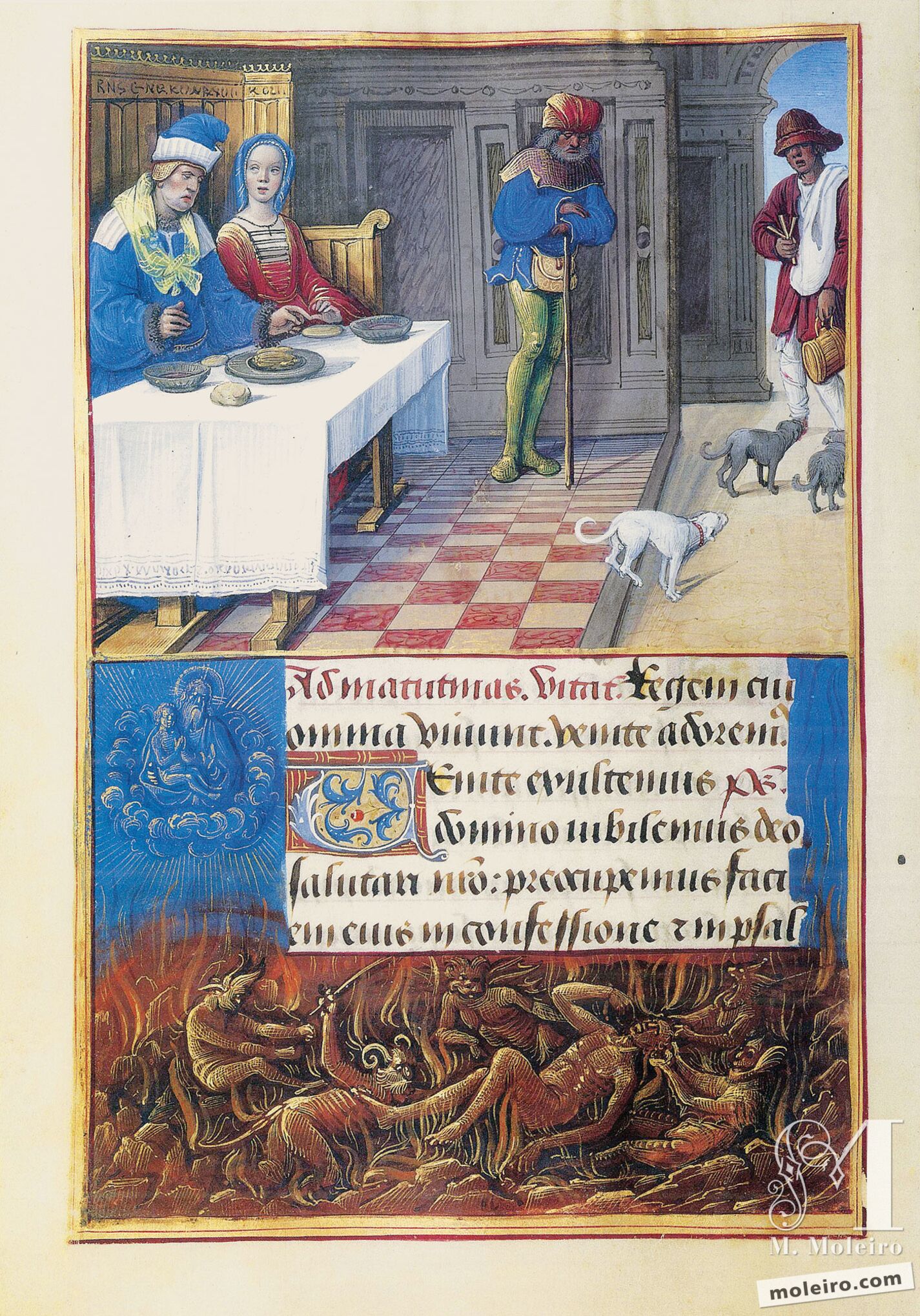The Feast of Dives derives from Luke’s parable of the rich man (16:19–31). According to the story, an unnamed rich man (the Latin word for a rich man, dives, in the Middle Ages became the man’s name) ate sumptuous meals every day. A poor man named Lazarus (not to be confused with the Lazarus resurrected by Christ) asked only for the crumbs that fell from his table. Nothing was given to him, and, adding insult, the rich man’s dogs would lick his sores. When the beggar died, he was carried by angels to the bosom of Abraham. Dives, however, ended up in hell from where, in considerable torment, he could see Lazarus cradled by the patriarch. He asked Abraham if Lazarus might dip the tip of his finger in water to cool his own burning tongue. Abraham replied that the riches Dives had received on earth had now to be paid for in eternity, while Lazarus, like all the poor, enjoys his reward in heaven.
In the miniature, the elegantly dressed Dives and his wife are about to start eating. She cautiously observes her husband as he points and casts a withering look toward Lazarus. Unobserved by a servant who seems to be asleep on his feet, the beggar approaches the table. He carries a small canteen and a clapper to warn passersby that he is a leper. His entry into the hall has attracted the attention of three dogs, which head toward the poor man. In the bottom margin, painted mostly in shades of orange and copper, Dives is tormented by flames and demons; he points to his mouth, asking for the single drop of water. In the celestial cool blue of heaven, the innocent soul of Lazarus, depicted as a nude child, calmly prays within Abraham’s protective arms. As discussed in chapter I, this border is based on the one Poyer painted in the slightly earlier Tilliot Hours (see chapter I).
Roger S. Wieck.
Curator, Medieval and Renaissance Manuscripts
The Morgan Library & Museum

The Feast of Dives derives from Luke’s parable of the rich man (16:19–31). According to the story, an unnamed rich man (the Latin word for a rich man, dives, in the Middle Ages became the man’s name) ate sumptuous meals every day. A poor man named Lazarus (not to be confused with the Lazarus resurrected by Christ) asked only for the crumbs that fell from his table. Nothing was given to him, and, adding insult, the rich man’s dogs would lick his sores. When the beggar died, he was carried by angels to the bosom of Abraham. Dives, however, ended up in hell from where, in considerable torment, he could see Lazarus cradled by the patriarch. He asked Abraham if Lazarus might dip the tip of his finger in water to cool his own burning tongue. Abraham replied that the riches Dives had received on earth had now to be paid for in eternity, while Lazarus, like all the poor, enjoys his reward in heaven.
In the miniature, the elegantly dressed Dives and his wife are about to start eating. She cautiously observes her husband as he points and casts a withering look toward Lazarus. Unobserved by a servant who seems to be asleep on his feet, the beggar approaches the table. He carries a small canteen and a clapper to warn passersby that he is a leper. His entry into the hall has attracted the attention of three dogs, which head toward the poor man. In the bottom margin, painted mostly in shades of orange and copper, Dives is tormented by flames and demons; he points to his mouth, asking for the single drop of water. In the celestial cool blue of heaven, the innocent soul of Lazarus, depicted as a nude child, calmly prays within Abraham’s protective arms. As discussed in chapter I, this border is based on the one Poyer painted in the slightly earlier Tilliot Hours (see chapter I).
Roger S. Wieck.
Curator, Medieval and Renaissance Manuscripts
The Morgan Library & Museum